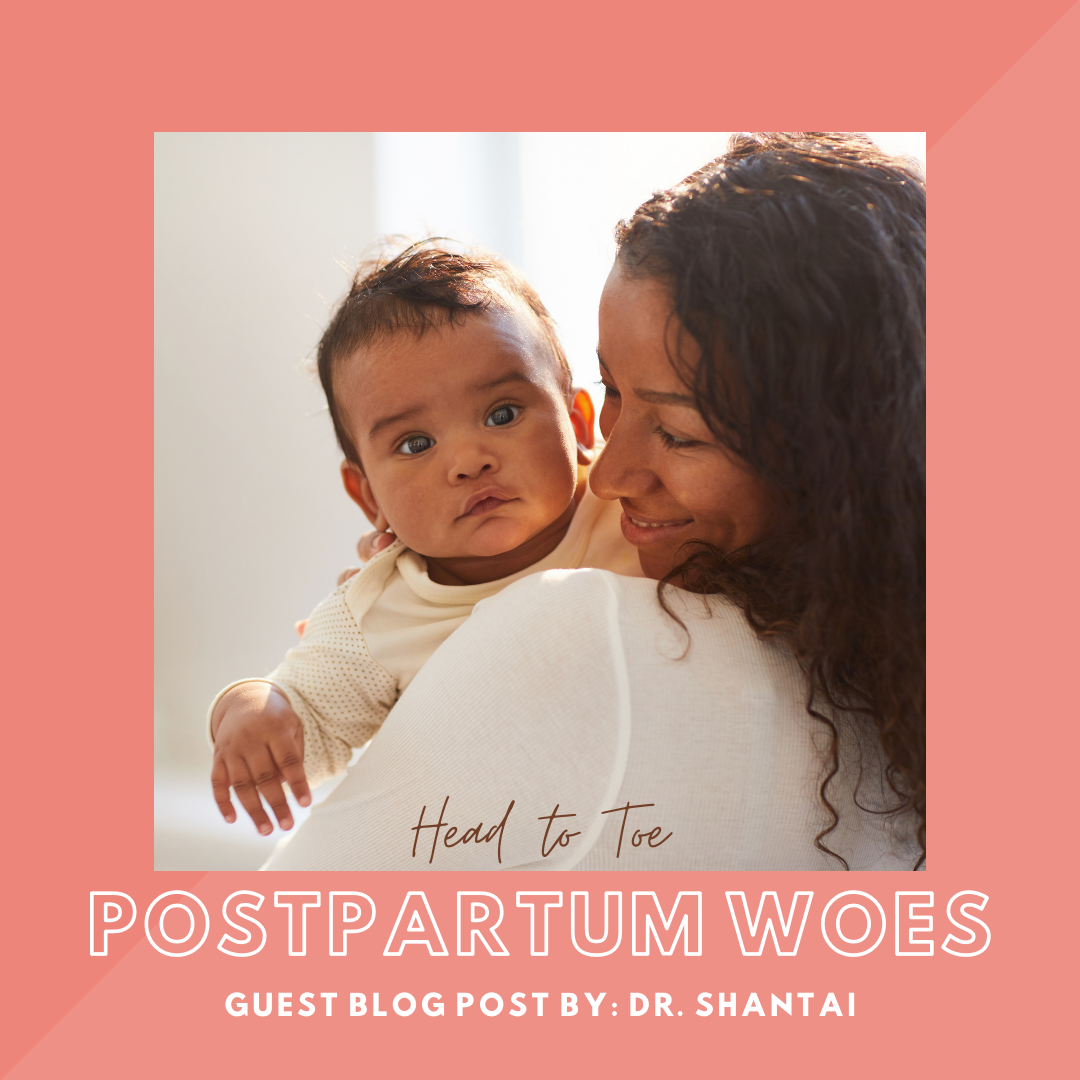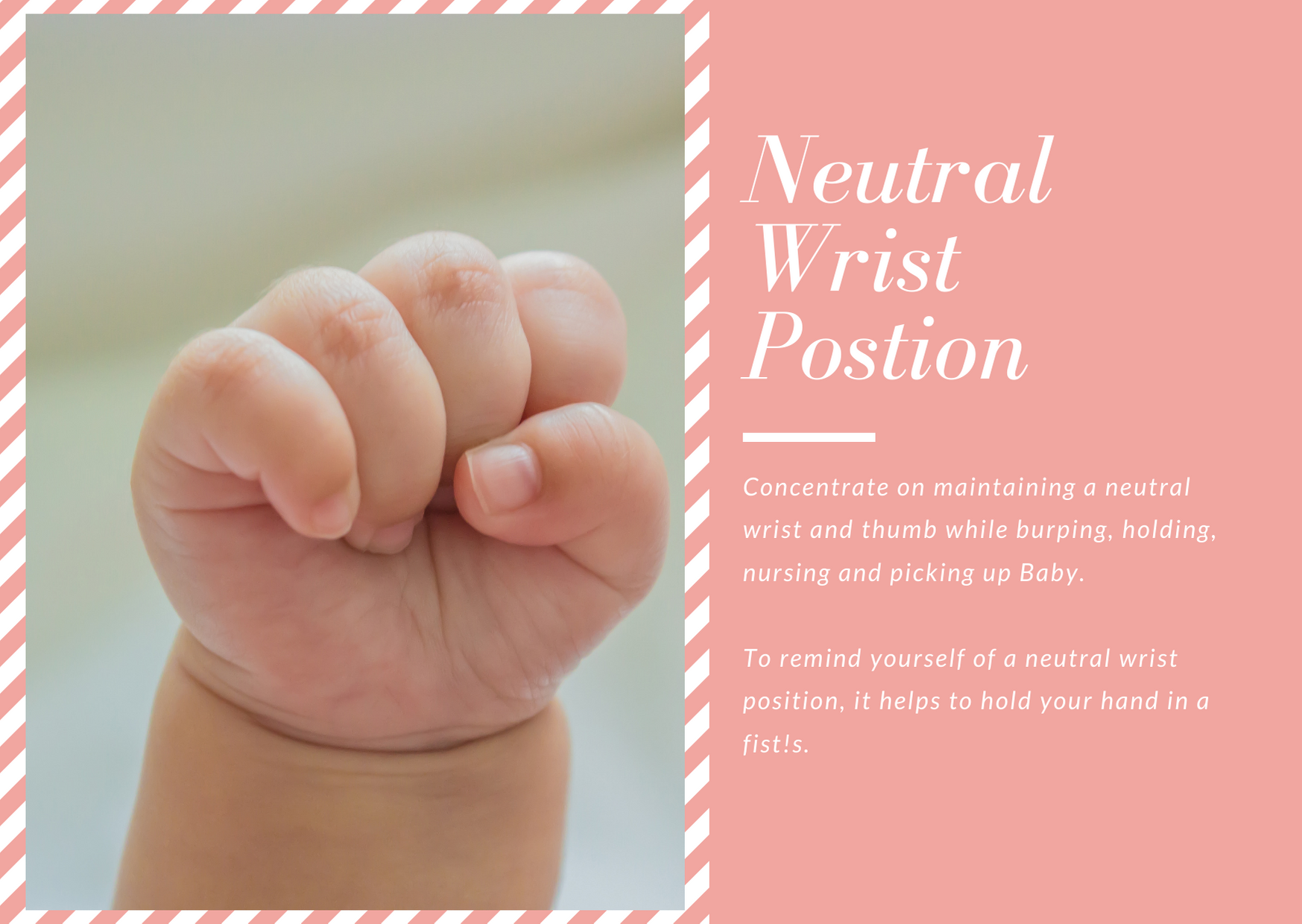Head to Toe Postpartum Woes
Mommy Care Team
Postpartum Neck, Back, Wrist and feet pain, and What to do About It.
Guest Blog Post By Dr. Shantai Watson, not only a licensed chiropractor but is dual certified in the US and Canada, with a special focus in prenatal, postpartum, and pediatric chiropractic care. She’s located in Denver, Colorado and you can learn more about her practice here .

You spend so much time preparing for your little bundle of joy to get here. You consider your birth team, baby toys, baby wardrobe, will you co-sleep? Which school district? When will you go back to work? But often, new moms report that what they did not know to prepare for was the myriad of all-too-common aches and pains that mothers experience after childbirth, and how to prevent them.
The female body is absolutely incredible and transforms so much from conception to pregnancy to childbirth to postpartum and breastfeeding.
Relaxin is the hormone responsible for allowing ligaments and muscles to loosen and relax, for helping the mammary glands prepare for lactation and for regulating mother’s cardiovascular and renal systems to help adapt to the increased demand for supplying nutrients to Baby. This hormone remains elevated longer than most people know. Up to 6 months after you are DONE breastfeeding, relaxin levels are still high.
Although relaxin is a very important and necessary hormone, it changes a woman’s overall stability, increasing her chance of injury and causing tight, sore muscles as they work hard to maintain stability. This, combined with holding awkward positions for long periods of time while nursing, rocking baby to sleep or carrying baby, mean that odds are, at some point in your postpartum journey, you will experience some form of musculoskeletal pain.
Common Pains and Pain Relief Methods
Neck Pain:
A common complaint I often see with moms is pain in the neck and shoulders from looking down at Baby. In particular, we see the left side of the head tilts lower from holding Baby on their left side so their right dominant arm is free.
What to Do About It:
Alternate arms used to carry your baby and the carseat. Be conscious about using both arms equally as much as possible, and keeping the shoulders back and ear lobes stacked directly over top your shoulders.

In addition to altering how you carry the car seat, a great exercise to strengthen your deep neck muscles is the “funky chicken”. Keeping your nose level, jut your chin out as far as possible, then bring your chin back to your neck, giving yourself the cutest double chin possible.
Upper Back Pain:
Due to a weakened core after pregnancy and constantly bending forward, nearly all postpartum, and especially breastfeeding, women experience upper back pain.
What to Do About It:
Be conscious of keeping your spine straight and in a neutral position as much as you can. Rather than bending forward to pick things up my hunching your back, squat, lunge and hinge at the hips as much as possible.

Rib Pain:
Due to poor breathing patterns and the constant forward flexed position, breastfeeding, changing baby, etc, upper ribs often go out of place. You might not know that’s what you are experiencing, but once you start feeling numbness and tingling into hands and arms, or feeling worse upper back pain with breathing, then you can be pretty sure the problem is your ribs.
What to Do About It:
Help the muscles that attach to your upper ribs to relax, by working on your breathing technique. First, take a deep breath in using only your chest. Now, remember what that felt like and try to avoid that in the future. Now, place your hand on your belly and take a deep belly breath, feeling your hand go up and down. This is better, but means your belly has to do a lot of work! Next, place your hands on the sides of your ribs.

Feel your breath expand laterally into your hands. We still want to see your belly going up and down, but we do not want your chest to go up and down. Intentionally practice this kind of breathing, which allows your diaphragm to do the work, allowing the muscles surrounding your upper ribs to relax.
Lower Mid Back Pain:
A common pain point postpartum women report is in their lower thoracic spine around T12. We often call it “pivot point pain”. That’s because while you are holding your upper back steady in order to hold Baby, you are using the lower part of your thoracic spine to do the rotation work to lift and reach for things.
What to Do About It:
Practice threading the needle. Sitting on your knees, with arms extended in front of you, lift your right arm as high to the sky as you can. Opening up your chest, take a deep breath. Then, weave your straightened right arm under your left arm, feeling a twist in your mid back. Repeat with the other arm.

Low Back Pain:
Research shows that low back and pelvic girdle pain is present in 45% of women during pregnancy and 25% have pain postpartum. Low back pain is especially common in women who have had a “belly birth” due to lying on their back during delivery and loss of deep core engagement.
What to Do About It:
The above thread the needle exercise can also help here. But rather than sitting down on your knees, do it while on your hands and knees. This allows you to involve your low back in the stretch. Cat/cow is another fantastic exercise to do on hands and knees.Alternate bringing your belly as high to the ceiling and as low to the ground as possible. Try it while sitting on your knees as well, to target your mid-back.

Sacrum, Pelvis and Pubic Bone:
During childbirth, the sacrum rocks backward, and the pelvic girdle separates outward to allow more space for Baby to move through. This can mean sacrum, tailbone and pubic bone pain. Baby also rotates during delivery, causing the sacrum to rotate too.
What to Do About It:
Strengthen those glutes and your core. Two of my favorites are, 1. Glute bridges and 2. Dead Bug.
To practice glute bridges, lie on your back with knees bent, drive your pelvis to the ceiling, squeezing your glutes.

Dead bug also starts lying flat on your back. your. Raise your arms straight, reaching towards the ceiling. Your knees and hips should be bent to 90 degrees. Now, alternating legs, slowly tap one heel down to the ground at a time, concentrating on keeping your spine flat to the floor and driving your belly button down to the ground.
Carpal Tunnel & Mommy’s Thumb:
The combination of high relaxin levels, repetitive movements like flexing the wrist to burp, pick up, hold or nurse Baby, and swelling or fluid retention makes postpartum moms more prone to have wrist and thumb pain and numbness.
What to Do About It:
Concentrate on maintaining a neutral wrist and thumb while burping, holding, nursing and picking up Baby. To remind yourself of a neutral wrist position, it helps to hold your hand in a fist! Try this before picking Baby up. It will help you form a healthy habit.

Plantar Fasciitis and Heel Pain:
Due to extra weight from pregnancy, relaxin and over-pronation of feet causing “falling arches”, often women experience extreme foot pain.
What to Do About It:
Place your feet flat on the ground. Leaving all other toes planted on the ground, lift only your big toe. This is an awesome exercise to help strengthen the intrinsic muscles of your feet.

Another tip is to freeze a filled plastic water bottle, and use it to give your feet a soothing ice massage. Lay the water bottle on its side, and press your foot into the bottle as you roll it back and forth.
What to Do If the Pain Persists?
While these are all helpful and effective stretches and exercises, sometimes they’re just not enough. As a general rule, if you have had a complaint for two weeks or longer, and have tried suggestions such as these and others from Dr. Google, it is probably time to consult a professional! This is important in order to resolve the issue before it becomes chronic, and to make your recovery as quick and painless as possible.
Chiropractors, such as myself, can be such integral members of your postpartum care team as we have the ability to assess exactly which muscles are weak or tight, which joints are moving too much, not enough or out of alignment and which movement patterns we need to correct. This not only helps you to get out of pain, but also to correct the root cause of the pain to make sure it does not return.
